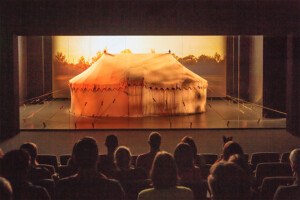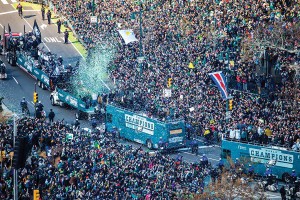Feature: The Story Behind The Philadelphia Story
The play attempts to aggressively telegraph the glen-plaid aura of the Main Line, establishing Tracy as the French-speaking, Bryn Mawr-educated equestrian great-granddaughter of the Lords of Rittenhouse Square. Upon learning that two tabloid reporters are about to invade her nuptials, Tracy turns indignant. “Why not the Drexels or Biddles or the qu’est-ce-que-c’est Cassats?” she asks.
[sidebar]It opened on March 29, 1939, at the Shubert Theater in New York, and its playbill took great pains to provide even more detailed context, helpfully including a lengthy treatise, titled simply “The Main Line,” that was accompanied by a series of jaunty cartoon characters partaking in the idle pastimes of the rich. Main Liners, the program stated for the benefit of the uninitiated, were “a vague mixture, to common city folk, of debutantes, horses, teas, balls, parties, promiscuous youths, society and money, particularly the latter two.” It described the Main Line social order as comprising two different castes, one being “arty” patrons of the Orchestra and the like. “The other — and larger — set, of which the Lords in The Philadelphia Story are distinctive members, is the hossy one.”
Hope Montgomery Scott was certainly a member of that latter set, which only fed Philadelphia’s fascination with her after Barry’s play took Broadway by storm. Already a legendary playgirl, she relished her reputation as both a bon vivant and a funny, earthy storyteller who drank and told dirty jokes. (Her personal stationery showed a caricature of a couple fornicating.) “I think she was delighted with it,” her son Edgar says of the notoriety wrought by the conjecture, which lasted all her life, that Tracy was based on her. “She liked recognition, she liked to be in the limelight, she liked to be somebody. And really, if it wasn’t for her and her side of the family, there wouldn’t have been any Philadelphia Story. So I think she felt it was all fair and square.”
It was a feeling Hepburn didn’t quite share. Over the course of her lifetime, she would insist that Tracy had been based primarily on her; the more years that passed, the higher the percentage climbed. “Phil said the character wasn’t all me,” she would tell her biographer, Charlotte Chandler. “He said that there was another girl he knew, and that my part was sort of a composite, even though I predominated. Well, I knew that was a lie. The part was all me.”
Befitting the woman of grace she was, Hope seemed more bemused than proprietary when the topic inevitably arose. In fact, within the Scott family there was lively conjecture that Tracy was actually based on Hope’s spunky younger sister Charlotte, a skilled show jumper known as Flopette. “If you asked her, ‘Was it you, Mom?,’ she’d say, ‘I think it was probably Floppy,’” says Edgar Jr.
Or not. The truth is that pieces of all three woman can be seen in Tracy Lord, from Hepburn’s fire and guile to Charlotte’s style and refinement to Hope’s mischievousness and naughty wit. One could easily imagine any of the trio turning to a guest in the south parlor and saying, as Tracy does to a flummoxed Liz and Mike, “And this is your first visit to Philadelphia. A quaint old place, don’t you think?”


